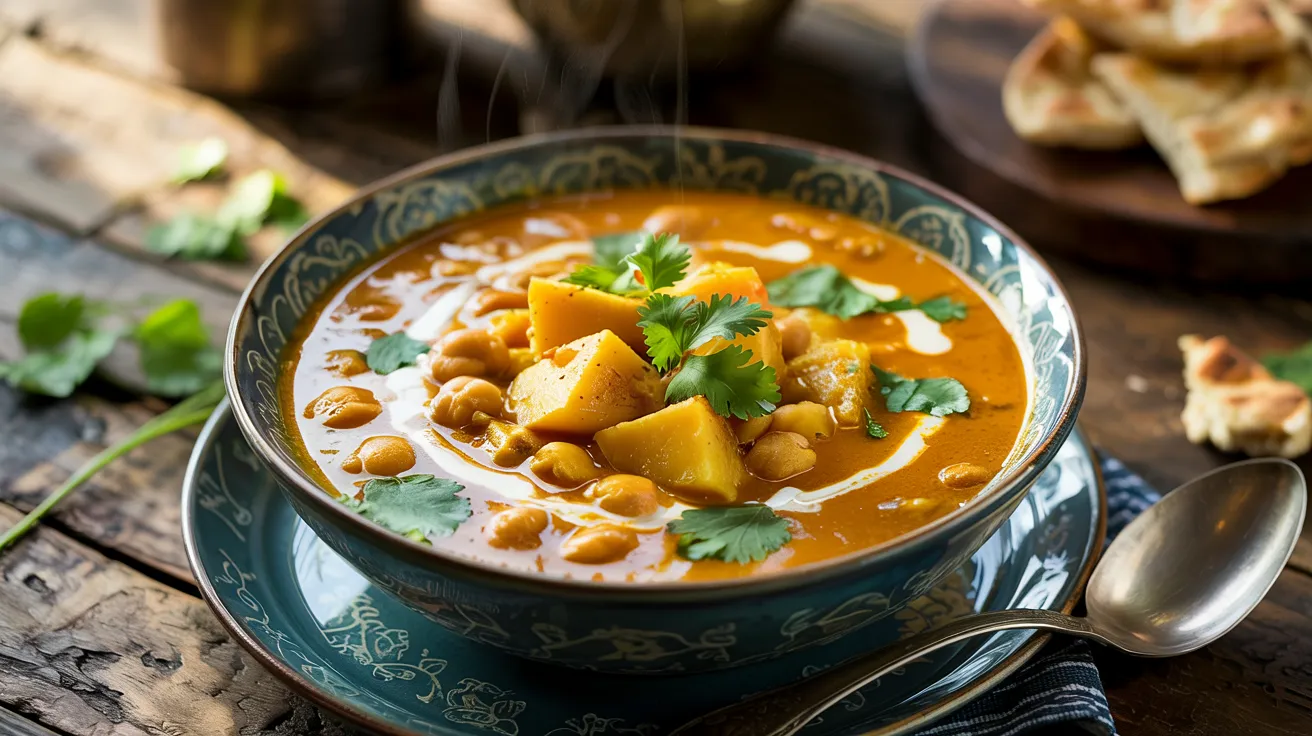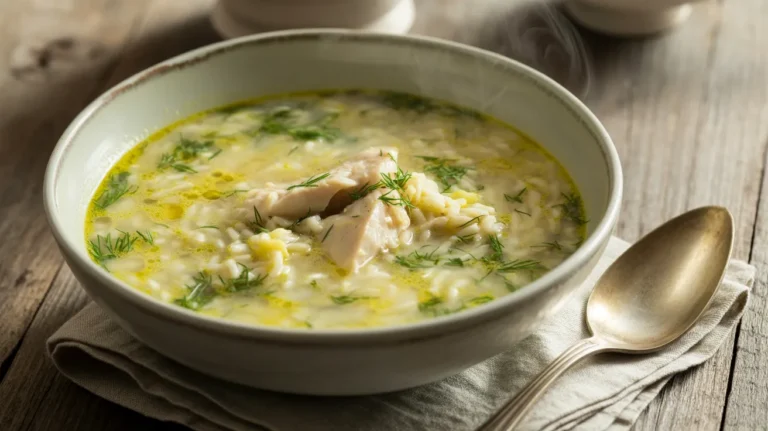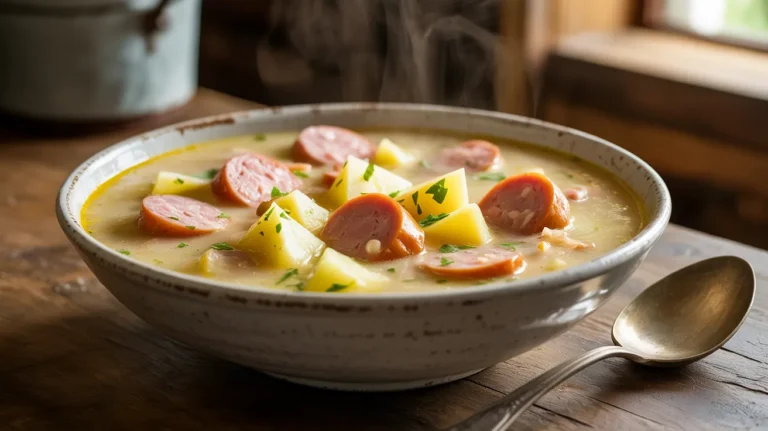This warming curry soup with chickpeas and potatoes transforms simple ingredients into a restaurant-quality meal that’s perfect for beginners. Packed with tender potatoes, protein-rich chickpeas, and aromatic spices, this curry soup with chickpeas and potatoes delivers incredible flavor in just 45 minutes using basic cooking techniques anyone can master.
RECIPE INFO
SERVES: 4 | PREP: 20 MIN | COOK: 25 MIN | TOTAL: 45 MIN
Ingredients
Aromatics & Spices
| Ingredient | Amount |
|---|---|
| Yellow onion, diced | 1 large |
| Fresh garlic, minced | 4 cloves |
| Fresh ginger, grated | 1 tablespoon |
| Curry powder | 2 tablespoons |
| Ground cumin | 1 teaspoon |
| Smoked paprika | 1 teaspoon |
| Red pepper flakes | 1/4 teaspoon |
Main Ingredients
| Ingredient | Amount |
|---|---|
| Yukon Gold potatoes, cubed | 1.5 pounds |
| Canned chickpeas, drained | 2 (15 oz) cans |
| Coconut milk, full-fat | 1 (14 oz) can |
| Vegetable broth | 3 cups |
| Diced tomatoes | 1 (14 oz) can |
| Olive oil | 3 tablespoons |
| Salt | 1 teaspoon |
| Black pepper | 1/2 teaspoon |
Finishing Touches
| Ingredient | Amount |
|---|---|
| Fresh cilantro, chopped | 1/4 cup |
| Lime juice | 2 tablespoons |
| Greek yogurt (optional) | For serving |
Detailed Step-by-Step Instructions for Beginners
Phase 1: Preparation and Setup (8-10 minutes)
- Set up your workspace first. Clear a large area on your counter near the stove. Place a cutting board, sharp knife, and all your ingredients within easy reach. Having everything organized makes cooking this curry soup with chickpeas and potatoes much smoother for beginners.
- Prepare the onion carefully. Remove the papery outer skin and cut off both ends. Cut the onion in half from top to bottom, then lay each half flat-side down. Make horizontal cuts (don’t cut all the way through), then vertical cuts to create small, uniform dice about 1/4-inch in size. Why this matters: Even-sized pieces cook at the same rate, preventing some from burning while others stay raw.
- Mince the garlic properly. Remove papery skin from each clove by crushing gently with the flat side of your knife. Chop roughly, then use your knife to mince into very small pieces. Beginner tip: If garlic sticks to your knife, rinse the blade with cold water and dry it.
- Grate the ginger using the small holes of a box grater. No need to peel young ginger – just scrub it clean. Visual cue: You’ll know you have enough when you see small, wet fibers and smell the fresh, spicy aroma.
- Prepare potatoes with care. Scrub potatoes clean but don’t peel them – the skin adds nutrition and texture. Cut into 1-inch cubes by first cutting the potato in half lengthwise, then cutting each half into strips, then cutting strips into cubes. Important: Keep all pieces the same size so they cook evenly in your curry soup.
- Drain and rinse chickpeas. Open both cans and pour contents into a fine-mesh strainer. Rinse under cold running water for 30 seconds to remove excess sodium and the thick liquid from the can. Why: This prevents the soup from becoming too thick or salty.
Phase 2: Building the Flavor Foundation (10-12 minutes)
- Heat your pot correctly. Use a large, heavy-bottomed pot (5-6 quart capacity works best). Place over medium heat and add 3 tablespoons olive oil. How to test: The oil is ready when it shimmers slightly but doesn’t smoke. If it starts smoking, remove from heat for 30 seconds.
- Cook onions with patience. Add diced onion to the hot oil and stir immediately to coat all pieces. Cook for 5-6 minutes, stirring every minute or so. Visual cues to watch for: The onion should become translucent (you can almost see through it) and soft when pressed with your spoon. The edges may turn slightly golden, which adds sweetness to your curry soup with chickpeas and potatoes.
- Add garlic and ginger at the right moment. Push onions to one side of the pot and add minced garlic and grated ginger to the empty space. Stir these aromatics constantly for 60-90 seconds. Warning sign: If they start turning dark brown, remove the pot from heat immediately – burnt garlic tastes bitter and will ruin your soup.
- Toast the spices properly. Add curry powder, cumin, smoked paprika, and red pepper flakes all at once. Stir constantly for 30-45 seconds. What you’re looking for: The spices should become very fragrant and slightly darker in color. This step is crucial – it wakes up the spices and creates the deep, complex flavor base for your curry soup.
Phase 3: Adding Liquids and Main Ingredients (5-7 minutes)
- Add broth gradually to prevent splashing. Pour vegetable broth slowly while stirring continuously. The liquid will sizzle and bubble when it hits the hot spices – this is normal. Safety tip: Stand slightly to the side to avoid any splashing hot liquid.
- Incorporate tomatoes properly. Add the entire can of diced tomatoes, including all the juice. Stir well to combine. Why this step matters: The acidity in tomatoes helps balance the richness of the coconut milk and enhances all the other flavors.
- Add potatoes and bring to a proper boil. Add cubed potatoes and stir gently to distribute evenly. Increase heat to medium-high. Visual cue: You’ll see large bubbles breaking the surface consistently across the entire pot. This usually takes 3-4 minutes from when you increase the heat.
Phase 4: Simmering Your Curry Soup with Chickpeas and Potatoes (15-18 minutes)
- Reduce heat and establish a gentle simmer. Lower heat to medium-low. The soup should have small bubbles gently breaking the surface – not a rolling boil. Cover the pot partially (leave about 1 inch gap) to prevent too much liquid from evaporating while still allowing steam to escape.
- Cook potatoes to perfect tenderness. Simmer for 12-15 minutes, stirring gently every 3-4 minutes to prevent sticking. Testing for doneness: Pierce a potato cube with a fork – it should go through easily without the potato falling apart. If the fork meets resistance, cook 2-3 minutes longer.
- Add chickpeas at the right time. Once potatoes are tender, add drained chickpeas and stir gently. Cook for 2-3 minutes just to heat them through. Beginner note: Since chickpeas are already cooked, they only need to warm up and absorb some of the curry flavors.
Phase 5: Final Touches and Serving (3-5 minutes)
- Incorporate coconut milk carefully. Remove pot from heat first, then slowly stir in the full can of coconut milk. Important technique: Stir in a figure-8 pattern to fully incorporate without splashing. The soup should turn a creamy, light brown color.
- Season thoughtfully. Add salt and black pepper, then taste with a clean spoon. Beginner guidance: Start with the amounts listed, then add more salt if needed – you can always add more, but you can’t take it away. The curry soup with chickpeas and potatoes should taste rich and well-balanced.
- Add bright finishing touches. Stir in fresh lime juice and chopped cilantro just before serving. Why last: These fresh flavors would be lost if added too early. The lime juice adds brightness that cuts through the rich coconut milk.
- Serve immediately while hot. Ladle into bowls and top with a dollop of Greek yogurt if desired. Serving tip: The yogurt adds cooling contrast and extra protein to make this curry soup with chickpeas and potatoes even more satisfying.
Chef’s Notes for Perfect Results
Temperature Control: Keep your heat at medium-low during simmering. High heat can cause the bottom to scorch and the coconut milk to separate, ruining the smooth texture of your curry soup with chickpeas and potatoes.
Spice Adjustment: Every curry powder is different. Taste after adding coconut milk and adjust with more curry powder, salt, or lime juice as needed. The flavor should be warm and complex, not overwhelming.
Texture Preference: For a thicker soup, mash about 1/4 of the potatoes against the side of the pot before adding coconut milk. This creates natural thickening.
Make-Ahead Success: This curry soup with chickpeas and potatoes improves overnight as flavors meld. Store covered in the refrigerator and reheat gently over low heat.
Nutrition Information (Per Serving)
- Calories: 385
- Protein: 12g
- Carbohydrates: 52g
- Fat: 16g
- Fiber: 11g
- Sodium: 890mg
Creative Variations of Curry Soup with Chickpeas and Potatoes
Protein-Enhanced Version: Add 1 pound diced chicken thighs in step 13 with the potatoes. Cook until internal temperature reaches 165°F before proceeding.
Garden Vegetable Style: Stir in 2 cups baby spinach, chopped kale, or diced bell peppers during the last 3 minutes of cooking for extra nutrition and color.
Comfort Food Twist: Create a heartier texture similar to our broccoli and potato soup by mashing half the cooked potatoes before adding coconut milk.
Spicy Heat Version: Double the red pepper flakes and add 1 minced jalapeño with the garlic and ginger. Balance the heat with cooling sides like our creamy roasted cauliflower soup.
Storage & Reheating Your Curry Soup
Refrigerator Storage: Cool completely before transferring to airtight containers. Store for up to 4 days. The curry soup with chickpeas and potatoes actually tastes better the next day.
Freezer Storage: Freeze in portion-sized containers for up to 3 months. Leave 1 inch headspace for expansion.
Perfect Reheating: Warm over medium-low heat, stirring frequently. Add extra broth if needed – the potatoes naturally thicken the soup as it sits.
Texture Changes: Reheated soup may be slightly thicker as potatoes continue to break down, creating an even creamier consistency.

Beginner’s Troubleshooting Guide
Problem: My curry soup with chickpeas and potatoes is too watery Detailed Solution: Simmer uncovered for 5-10 more minutes to evaporate excess liquid. Alternatively, mash 4-5 potato pieces against the pot side to naturally thicken.
Problem: The soup tastes bland despite following the recipe Detailed Solution: Add salt first (1/4 teaspoon at a time), then taste. If still flat, add 1 tablespoon lime juice or 1/2 teaspoon more curry powder. Salt enhances all other flavors.
Problem: My coconut milk looks curdled or separated Detailed Solution: This happens when the soup gets too hot. Remove from heat and stir gently. The appearance doesn’t affect taste, but prevent it by keeping heat at medium-low.
Problem: Potatoes are falling apart and mushy Detailed Solution: This means they were overcooked. Next time, test doneness earlier and cut pieces slightly larger. Mushy potatoes still taste good and naturally thicken the soup.
Problem: The bottom of my pot is sticking or burning Detailed Solution: Your heat is too high. Reduce to medium-low and stir more frequently. Add a splash of broth if needed to deglaze any stuck bits.
Essential Equipment for Making Curry Soup
- Large heavy-bottomed pot (5-6 quart capacity prevents scorching)
- Sharp chef’s knife (8-inch works well for all chopping tasks)
- Stable cutting board (wood or plastic, preferably large)
- Wooden spoon (won’t scratch pot and handles heat well)
- Can opener (for chickpeas, tomatoes, and coconut milk)
- Box grater (for fresh ginger)
- Measuring cups and spoons (dry and liquid measures)
- Ladle (for neat serving)
Complete Shopping List
Produce Section
- 1 large yellow onion
- 1 head fresh garlic
- 1 piece fresh ginger (2-inch piece is plenty)
- 1 bunch fresh cilantro
- 2 fresh limes
- 1.5 pounds Yukon Gold potatoes
Spice Aisle
- Curry powder (check expiration date for best flavor)
- Ground cumin
- Smoked paprika
- Red pepper flakes
Canned Goods
- 2 cans chickpeas (15 oz each, any brand)
- 1 can full-fat coconut milk (14 oz, shake before using)
- 1 can diced tomatoes (14 oz, no salt added preferred)
- 32 oz container vegetable broth (or chicken broth)
Pantry Basics
- Extra virgin olive oil
- Salt and black pepper
Dairy (Optional)
- Plain Greek yogurt for serving
Five Success Secrets for Perfect Results
- Master the spice-toasting technique – cooking spices in oil for 30-45 seconds releases essential oils that create the signature deep flavor in curry soup with chickpeas and potatoes.
- Never rush the onion foundation – properly softened, translucent onions create the sweet base that balances all the warming spices throughout the soup.
- Test potato doneness frequently – start checking after 10 minutes of simmering. They should be fork-tender but still hold their shape when gently stirred.
- Remove from heat before adding coconut milk – this single step prevents curdling and maintains the silky, smooth texture that makes this curry soup irresistible.
- Taste and adjust seasonally – every batch needs slightly different seasoning based on your ingredients. Trust your palate and adjust salt, lime juice, or spices to achieve perfect balance.
This beginner-friendly curry soup with chickpeas and potatoes recipe creates a satisfying, restaurant-quality meal using simple techniques and common ingredients. The detailed instructions ensure success even for first-time cooks, while the rich combination of warming spices, creamy coconut milk, and hearty vegetables makes it perfect for any occasion. Serve with warm naan bread, rice, or crusty bread for a complete, comforting dinner that everyone will love.




